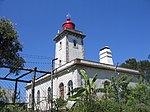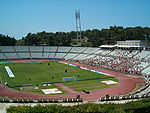Gibalta Lighthouse
Buildings and structures in Oeiras, PortugalLighthouses in Portugal

The Gibalta Lighthouse (Portuguese: Farol da Gibalta) is an active Portuguese lighthouse located at Oeiras, about 10 km west of the centre of Lisbon. It is a white cylindrical tower with dome and red veins, with illumination being supplied by a red fluorescent light. It was rebuilt in 1954 following a landslide which destroyed the old light and killed ten people on a passing train.
Excerpt from the Wikipedia article Gibalta Lighthouse (License: CC BY-SA 3.0, Authors, Images).Gibalta Lighthouse
Passeio Marítimo Caxias - Cruz Quebrada, Oeiras e São Julião da Barra, Paço de Arcos e Caxias
Geographical coordinates (GPS) Address External links Nearby Places Show on map
Geographical coordinates (GPS)
| Latitude | Longitude |
|---|---|
| N 38.699111111111 ° | E -9.2663888888889 ° |
Address
Farol da Gibalta Barra do Sul Range
Passeio Marítimo Caxias - Cruz Quebrada
2760-064 Oeiras e São Julião da Barra, Paço de Arcos e Caxias
Portugal
Open on Google Maps





